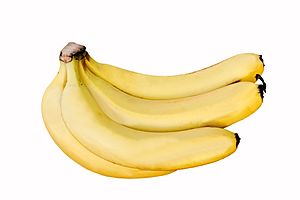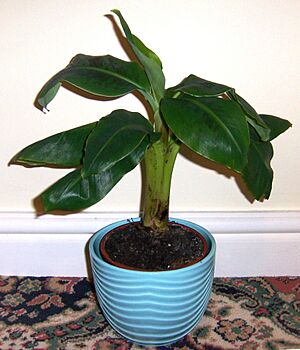Cavendish banana facts for kids
Quick facts for kids Cavendish |
|
|---|---|

A bunch of Cavendish bananas
|
|
| Species | Musa acuminata |
| Cultivar group | Cavendish subgroup of the AAA Group |
| Cultivar group members | See text |
Cavendish bananas are a very popular type of banana. They are the fruits of special banana plants. The name "Cavendish" also refers to the plants themselves.
These bananas include important types like 'Dwarf Cavendish' and 'Grand Nain'. You might know 'Grand Nain' as the "Chiquita banana." Since the 1950s, Cavendish bananas have been the most traded bananas around the world. They became popular after the Gros Michel banana was badly damaged by a plant sickness called Panama disease.
Cavendish bananas cannot make seeds to grow new plants. Instead, new plants are grown from parts of old ones. This means all Cavendish bananas are almost exact copies, like clones. Because they are all so similar, they don't have much genetic diversity. This makes them very easy targets for diseases and fungal outbreaks. If a disease can harm one Cavendish plant, it can easily harm them all. This puts the future of Cavendish bananas at risk.
Contents
How Cavendish Bananas Were Grown
Cavendish bananas got their name from William Cavendish, 6th Duke of Devonshire. Around 1834, he received some banana plants from Mauritius. His head gardener, Sir Joseph Paxton, grew these plants in the greenhouses at Chatsworth House. Paxton described these plants as Musa cavendishii, named after the Duke.
The Chatsworth bananas were sent to different places in the Pacific around the 1850s. Some might have reached the Canary Islands. However, other experts think bananas were already in the Canary Islands much earlier. They believe Portuguese explorers brought them from West Africa. In 1888, Thomas Fyffe imported bananas from the Canary Islands to England. These bananas are now known as the 'Dwarf Cavendish' type.
Cavendish bananas started being grown for sale in large amounts in 1903. But they only became really famous later. This happened in the 1950s when Panama disease attacked the main banana type, the Gros Michel. People thought Cavendish bananas were stronger against this disease.
However, in 2008, reports from Sumatra and Malaysia showed that Panama disease was starting to attack Cavendish bananas too. In 2019, a very serious type of Panama disease (TR4) was found in the Americas. There is no medicine to stop TR4. This means Cavendish bananas might face the same sad end as the Gros Michel banana.
Types of Cavendish Bananas
Cavendish bananas are a special group of bananas. They come from the Musa acuminata plant.
There are different types of Cavendish bananas. They are known by how tall the plant grows and what the fruit looks like. Some important types for eating include 'Dwarf Cavendish', 'Grande Naine', 'Lacatan', and 'Valéry'. 'Grande Naine' is the most important type sold around the world. 'Dwarf Cavendish' is the most common type grown. 'Grande Naine' is also known as the Chiquita banana.
How We Use Cavendish Bananas
Between 1998 and 2000, Cavendish bananas made up almost half of all bananas grown worldwide. They are also most of the bananas sold between countries.
You can eat Cavendish bananas raw. People also use them in baking, fruit salads, and with other foods. When you buy them, their skin is often a bit green. It turns yellow as the fruit gets ripe. As it ripens, the starch inside changes into sugar, making the banana sweet. When it's very ripe, you might see brown or black "sugar spots." If it gets too ripe, the skin turns black and the fruit becomes soft.
Bananas can ripen naturally after they are picked. Or, they can be made to ripen faster by being exposed to a gas called ethylene. Ripe bananas give off natural ethylene, which smells sweet. Most stores sell bananas that are partly ripe. The best ones for eating right away are usually fully yellow with some sugar spots. Cavendish bananas have special codes called PLUs. Yellow ones are 4011, and smaller yellow ones are 4186. Organic Cavendish bananas have the PLU 94011.
Diseases Affecting Bananas
Cultivated bananas do not have seeds. They grow from parts of other plants. This means they don't develop ways to fight off diseases as quickly as plants that grow from seeds. So, finding new types of bananas that can resist diseases is the main way to protect them. This helps protect banana plants from sicknesses like bacterial wilt and Fusarium wilt, also known as Panama disease.
Images for kids
See also
 In Spanish: Banana Cavendish para niños
In Spanish: Banana Cavendish para niños





